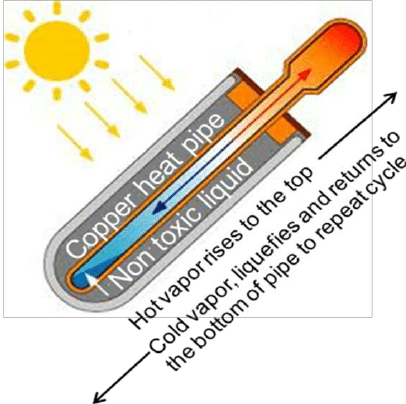you are thinking the older Siemens version of evacuated solar heaters… the Chinese’s version are manufactured differently then the older version manufactured by Siemens ( which were prone to vacuum loss and a fairly quick failure rate due to vacuum loss ) - the Chinese’s version which probably +99% of all evacuated solar water heaters sold are … they are basically built like a long clear vacuum thermos bottle with a copper pipe inserted held in with a silicone plug
example image off the web
 or
or 
Well, I’ve learnt something new today!
And just to be clear, you remove the heatpipe from the glass and push 6" of 304 onto the lower end (in your diagram) of the heatpipe and reassemble?
thats pretty much it – the hardest part of the whole process is finding the correct 304 tube with the correct I.D compared to the O.D of the heat pipe… as you need a couple thousandths of play to be able to slide it on. then just use a a flare tool vice to crimp it to the heatpipe . squeeze it tight then just hit it on the side with a hammer to crimp
… it does not need to be 6 inches long 4 inches in more then enough… chances are you need a 3/8 tubing then you just buy the one with a different wall thickness that brings it down to the correct I.Dexample:
http://www.speedymetals.com/c-8276-round-tube.aspx?thickness=0.375
. https://sash991.wixsite.com/mysite/single-post/2017/02/28/Hybrid-HeatpumpEvacuated-solar
This is really great and makes so much sense. I’ve thought very much about solar thermal/heat pump combos in recent years. The colder months are easily boosted with a hp I’m sure.
Interestingly, the poorer performing collectors, flat plate style poorer insulated, can kind of double up as an air-source, so the worse the collector the more effective the upgrade with a hp in a way.
I also think typical flat plate tech with a plain PV panel layered on top is theoretically a good idea also, when I have time and money I will simply get some cheap household wall mounted radiators and mount them to the back of solar panels with some kind of thermal silicone and brackets to the frame, and use the solar electrical energy to run a hp to extract thermal energy from the back of the PVs, the cooling effect will also benefit the PV performance.
There are commercially available systems that use a heat pump with the evaporator (cold side) shaped like a flat black panel for solar gain. It contains the refrigerant gas, so pretty lightweight and simple. The condenser (hot side) heats your water.
They claim it still works when covered in snow or at night, just with a lower efficiency. Probably not suitable for those who tough it out at -20C.
I wonder if your spin would cool the PV panels making them more efficient? (It’s a very flat refrigerant panel, so easier to get good heat transfer!)
You could be on to something there!
Cool. Took a while to find, but are they called thermodynamic panels?
Edit: Even better, some diagrams here too. Solar-Assisted Heat Pump Systems: A Review of Existing Studies and Their Applicability to the Canadian Residential Sector | J. Sol. Energy Eng. | ASME Digital Collection
Thanks.
